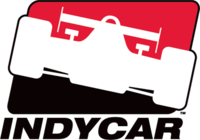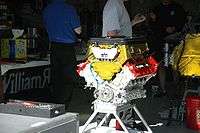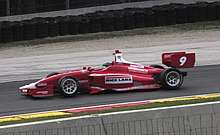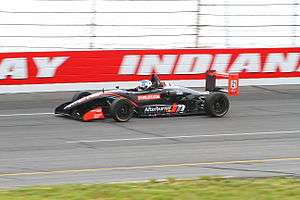IndyCar
INDYCAR, LLC, is an American-based auto racing sanctioning body for Indy car racing and other disciplines of open wheel car racing. The organization sanctions five racing series: the premier IndyCar Series[2] with its centerpiece the Indianapolis 500, developmental series Indy Lights, the Indy Pro 2000 Championship and the U.S. F2000 National Championship, which are all a part of The Road To Indy & the Global Mazda MX-5 Cup.[3] IndyCar is recognized as a member organization of the FIA through ACCUS.
 | |
| Sport | Auto Racing |
|---|---|
| Category | Open-wheel cars |
| Jurisdiction | |
| Founded | 1994[1] |
| Affiliation | ACCUS-FIA |
| Affiliation date | 1996 |
| Headquarters | Indianapolis, IN |
| President | Jay Frye |
| Official website | |
| indycar | |
The sanctioning body was formed in 1994 under the name Indy Racing League by Hulman & Company, which also owned the Indianapolis Motor Speedway complex, and began competition in 1996. The trademark name INDYCAR was officially adopted on January 1, 2011. The sport of open-wheel car racing itself, also historically referred to as Championship Car racing or Indy racing, traces its roots to as early as 1905. It is the fifth major sanctioning body to govern the sport of Indy car racing, following AAA, USAC, CART, and Champ Car.
Today, IndyCar is owned by Roger Penske via Penske Entertainment Corp a subsidiary of Penske Corporation. Penske purchased IndyCar and the Indianapolis Motor Speedway from Hulman & Co. in November 2019.[4]
Indycar
IndyCar Series
The League's premier series debuted in 1996 under the name Indy Racing League. The series adopted the name Indy Racing League IndyCar Series in 2003. With Verizon as corporate sponsor from 2014 through 2018, the series has been known as the Verizon IndyCar Series. On January 15, 2019, it was announced that NTT Corporation (Nippon Telegraph and Telephone) would become the title sponsor and the series will become the NTT IndyCar Series.
The series initially raced exclusively on oval tracks, as the series was founded partly in response to the increasing prominence of road and street courses on the CART schedule. In 2005, the series abandoned its unofficial ovals-only stance, and added three road–street course events.[5] By 2009, the series had a roughly 50/50 split of ovals and road/street courses. Presently, the series currently runs one-third of its schedule on ovals and the rest on road and street circuits.
Indy Lights
Indy Lights is the development series for the IndyCar series.[6] The Indy Lights concept traces its roots back the USAC Mini Indy Series of the late 1970, and the CART ARS/Indy Lights series that began in 1986. The current Indy Lights series debuted in 2002 under the name Infiniti Pro Series. After the 2008 open wheel unification, the Indy Lights name returned. The Indy Lights typically run as support races to IndyCar Series races, but occasionally has run stand-alone races, or as a support race of other events. The series is now promoted by Andersen Promotions.
Indy Pro 2000
The Indy Pro 2000 Championship presented is an open-wheel racecar driver development series in North America. Competitors use spec cars built by Tatuus. The original series, using first-generation tube-frame cars started in the early 1990s. The second-gen, high-tech, carbon-fiber car was released in 2004. From 2017, the series has used spec Tatuus PM-18s. The series has historically included road courses, street courses, and ovals. The series' primary sponsors is Cooper Tire and the cars, while purpose built for the track with carbon fiber monocoques, are powered by 275 horsepower Mazda-prepared 2 liter MZR-PM18A engines. The series' stated goal is "to develop new race driving talent." In 2010, the series became a part of The Road to Indy. In 2013 the series' promotion was taken over by Andersen Promotions. In 2019, following the departure of Mazda as an official sponsor, the series was rebranded as Indy Pro 2000 from its previous Pro Mazda name.
U.S. F2000
USF2000 is a series the organisation started sanctioning in 2010. Originally started in 1991 and folded in 2006, it was restarted in 2010 as part of the "Road to Indy" ladder series promoted by Andersen Promotions. The series utilizes tube frame Formula Ford chassis fitted with larger Mazda MZR four cylinder engines and wings and slicks and was originally based on the Formula Continental rules formula.
History
IndyCar name
The term "Indy Car" began as a nickname for the cars that competed in USAC's "Championship" division of open-wheel auto racing in the United States, deriving from the sport's most popular competition, the Indianapolis 500. The division's link with Indianapolis soon resulted in the term supplanting the official descriptor, "champ car," in common use and promotions.
The term continued to be used by USAC's replacement as the dominant governing body for open-wheel racing, Championship Auto Racing Teams, which called its main series the "CART PPG Indy Car World Series" despite the body not sanctioning the 500. In 1992, during an attempt by CART to broaden their board membership, the Indianapolis Motor Speedway registered the camel case trademark IndyCar with the United States Patent and Trademark Office and licensed it to CART as their new tradename.
In 1996, Indianapolis Motor Speedway President Tony George launched a new national championship racing series, the USAC sanctioned Indy Racing League. This resulted in a legal battle over the IndyCar trademark: In March 1996, CART filed a lawsuit against the Indianapolis Motor Speedway in an effort to protect their license to the IndyCar mark after the Indianapolis Motor Speedway had attempted to terminate it.[7] In April, the Indianapolis Motor Speedway filed a separate lawsuit against CART to prevent them from further use of the mark.
Eventually a settlement was reached in which CART agreed to give up the use of the IndyCar mark following the 1996 season and the IRL agreeing not to use the name before the end of the 2002 season.[8] CART returned to branding as simply CART for 1997, and resurrected the term "champ car" to describe their vehicles.
Following a six-year hiatus, the Indy Racing League announced it would rename their premier series the IndyCar Series for the 2003 racing season; CART followed suit by renaming their main series the Champ Car World Series.
Post-unification, a heavy emphasis has been placed on deemphasizing the legal entity name and its initials and replacing it with the IndyCar name. This became official on January 1, 2011, as Indy Racing League LLC adopted as its trade name INDYCAR. On November 1, 2013, the company's legal name was changed to INDYCAR LLC.[9]
Split with CART
The dispute between CART and IRL centered on the Indianapolis 500, long considered the flagship race of the sport. From 1980 until 1995, the Indy 500 continued to be sanctioned by USAC while being run predominantly with drivers from CART and counting toward CART's standings. George felt that his opinions regarding increasing costs, and revenue sharing were being ignored, while CART teams owners felt George used his influence over USAC to have a disproportionate impact on the general operation of the sport.
After a number of attempts at a compromise board failed, IMS formed the Indy Racing League in 1994, with the series being slated to begin racing in 1996. CART had primarily sanctioned Indy car racing since 1979, when the organization broke away from USAC. George blueprinted the IRL as a lower-cost open-wheel alternative to CART, which he viewed had become technology-driven and dominated by a few wealthy multi-car teams. The IRL was designed only to run on oval tracks to promote American drivers from the midget and sprint car ranks to graduate to Indycars the way that of Indy racing A.J. Foyt, Mario Andretti, Johnny Rutherford, and the Unsers had in the 1960s.
Starting with the first IRL season, the league proclaimed that 25 of the 33 spots in the Indy 500 starting grid for cars from full-time IRL teams.[10] In 1996, CART retaliated by scheduling what was supposed to become its new showcase event, the U.S. 500, at Michigan International Speedway on Memorial Day, the traditional date for the Indy 500.
The new 1997 technical rules featured less expensive chassis and "production-based" engines that were purchased rather than leased, but most importantly, were technically incompatible with CART specifications. The IRL's early seasons consisted of sparse schedules and inexperienced teams, with the degradation in quality especially apparent during the Indianapolis 500, which saw a dramatic decline in prestige.
The IRL began to draw top teams from CART starting in 2002, contributing to the latter's bankruptcy, re-branding as Champ Car in 2003,[11] and ultimate demise and absorption by the IRL in 2008.
After absorbing Champ Car, the IndyCar Series became similar in many ways to the CART series from which it separated and its related European open-wheel formula counterparts: former prominent CART teams such as Chip Ganassi Racing and Team Penske are frequent race winners, there is a strong contingent of foreign-born drivers, the cars are increasingly electronic and aero dependent and the schedule includes more road and street courses than oval tracks.
Unification with Champ Car
On January 23, 2008, Tony George offered Champ Car management a proposal that included free cars and engine leases to Champ Car teams willing to run the entire 2008 IndyCar Series schedule in exchange for adding Champ Car's dates at Long Beach, Toronto, Edmonton, and Australia to the IndyCar Series schedule, effectively reuniting American open-wheel car racing.[12] The offer was initially made in November 2007.[12] On February 10, 2008, Tony George, along with IRL representatives Terry Angstadt and Brian Barnhart, plus former Honda executive Robert Clarke, traveled to Japan to discuss moving the Indy Japan 300 at Twin Ring Motegi.[13] Moving that race, or postponing it, would be required in order to accommodate the Long Beach Grand Prix, which was scheduled for the same weekend.[13] Optimism following the meeting was high.[14]
In February 2008, Indy Racing League founder and CEO Tony George and owners of the Champ Car World Series completed an agreement to unify the sport for 2008.[15] The result was that the Champ Car World Series was suspended except for the Long Beach Grand Prix. Many of the former Champ Car teams moved to the IndyCar Series using equipment provided by the League.
Randy Bernard was announced as the new IRL CEO in February 2010.[16] In 2011, the sanctioning body dropped the Indy Racing League name, becoming IndyCar to reflect the merged series. The new Dallara DW12 racecar was introduced for the 2012 season. IndyCar collaborated with DreamWorks Animation to launch comedy film Turbo in 2013. Bernard was fired in October 2012, and replaced by Mark Miles.
Driver safety
Driver safety has also been a major point of concern, with a number of drivers seriously injured, particularly in the early years of the series. There have been five fatal crashes in the history of the series. Compared to road racing venues, the lack of run-offs on oval tracks, coupled with higher speeds due to the long straights and banked turns, means that there is far less margin for error. Car design was attributed as a leading cause of early injuries, and the series made improvements to chassis design to address those safety concerns. Following a series of spectacular high-profile accidents in 2003, including American racing legend Mario Andretti and former champion Kenny Bräck, as well as the death of Tony Renna in testing at Indianapolis, the IRL made additional changes to reduce speeds and increase safety.
IndyCar was the first racing series to adopt the SAFER soft wall safety system, which debuted at the Indianapolis 500 and has now been installed at almost all major oval racing circuits. The SAFER system research and design was supported and funded in large part by the Hulman-George family and the Indianapolis Motor Speedway.
Fatalities





- (Extended list here: List of IndyCar fatalities)
Gallery
 The Honda engine that Indycar would use from 2006 until 2011.
The Honda engine that Indycar would use from 2006 until 2011..jpg) Simon Pagenaud during 2019 Indianapolis 500.
Simon Pagenaud during 2019 Indianapolis 500.

See also
- Indianapolis Motor Speedway
- Indianapolis Motor Speedway Radio Network
- American Automobile Association
- United States Auto Club
- Champ Car
- List of IndyCar Series teams
- List of IndyCar Series racetracks
- List of American Championship Car Rookie of the Year Winners
- List of American Championship car racing point scoring systems
References
- "2011 Las Vegas Accident Information" (PDF). Archived (PDF) from the original on 2013-02-25. Retrieved 2012-07-11.
- "IndyCar lands Title Sponsor". IndyStar.com. Archived from the original on November 6, 2009. Retrieved 2009-11-03.
- https://www.mx-5cup.com/news/mazda-and-indycar-announce-extension-of-global-mx-5-cup-sanctioning-agreement
- "Indianapolis Motor Speedway (@IMS) | Twitter". twitter.com. Retrieved 2019-11-04.
- "St. Petersburg is site for IRL changes". Tampa Bay Times. January 22, 2005. p. 33 – via Newspapers.com.
- "IndyCar turns over rights to Indy Lights". The Missoulian. July 13, 2013. p. 37 – via Newspapers.com.
- 1948-, Whitaker, Sigur E. (2015-10-27). The Indy Car wars : the 30-year fight for control of American open-whell racing. Jefferson, North Carolina. p. 76. ISBN 9781476619804. OCLC 926914971.CS1 maint: numeric names: authors list (link)
- 1948-, Whitaker, Sigur E. (2015-10-27). The Indy Car wars : the 30-year fight for control of American open-whell racing. Jefferson, North Carolina. p. 81. ISBN 9781476619804. OCLC 926914971.CS1 maint: numeric names: authors list (link)
- "INBiz: Your one-stop source for your business". bsd.sos.in.gov. Retrieved 2019-05-19.
- 1948-, Whitaker, Sigur E. (2015-10-27). The Indy Car wars : the 30-year fight for control of American open-whell racing. Jefferson, North Carolina. p. 70. ISBN 9781476619804. OCLC 926914971.CS1 maint: numeric names: authors list (link)
- 1948-, Whitaker, Sigur E. (2015-10-27). The Indy Car wars : the 30-year fight for control of American open-whell racing. Jefferson, North Carolina. p. 107. ISBN 9781476619804. OCLC 926914971.CS1 maint: numeric names: authors list (link)
- "Tony George Makes an Offer for Unity". SpeedTV.com. 2008-01-23. Archived from the original on 2008-01-27. Retrieved 2008-01-23.
- "George off to Japan in pursuit of unification". IndyStar.com. 2008-02-09. Archived from the original on 2008-02-18. Retrieved 2008-02-13.
- "Official optimistic IRL-Champ Car merger talks will continue". IndyStar.com. 2008-02-12. Archived from the original on November 6, 2011. Retrieved 2008-02-13.
- "Done Deal". IndyCar.com. Archived from the original on 2008-03-13. Retrieved 2010-08-22.
- Lewandowski, Dave (2010-02-02). "Meet the CEO". IndyCar Series. Indy Racing League. Archived from the original on 2011-06-05. Retrieved 2010-02-02.
- "AP". Archived from the original on 2015-11-07.